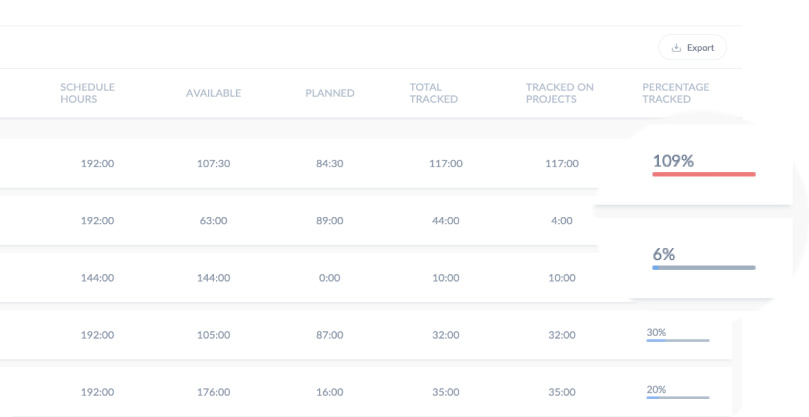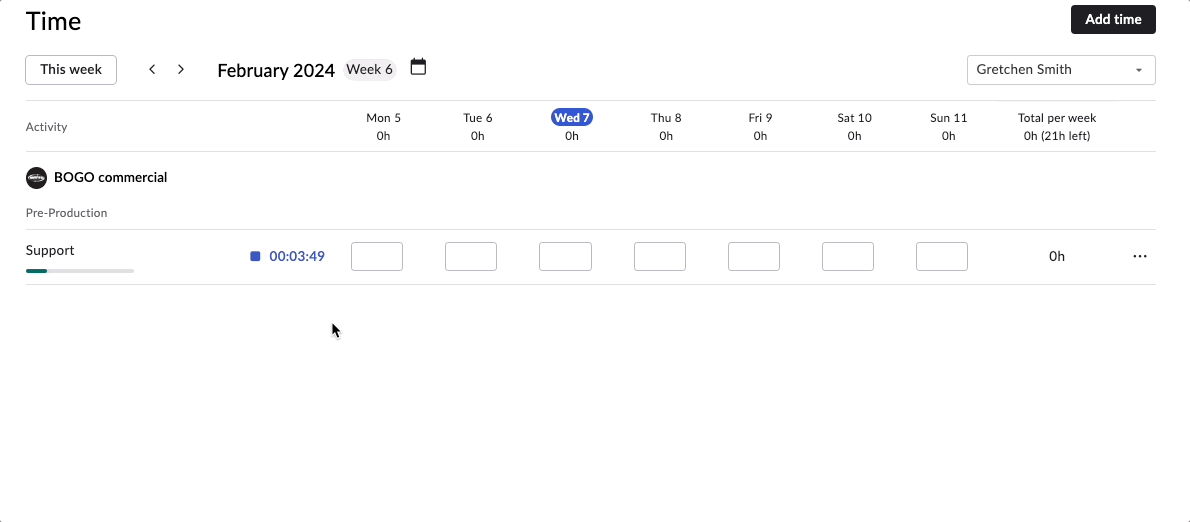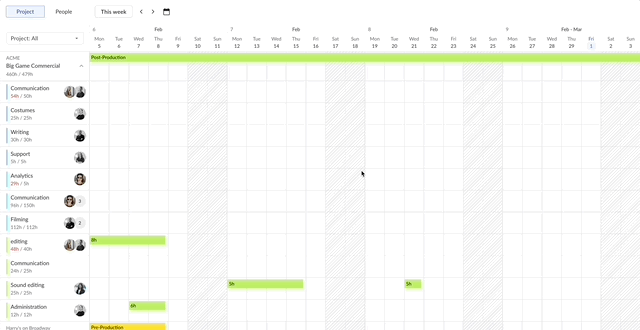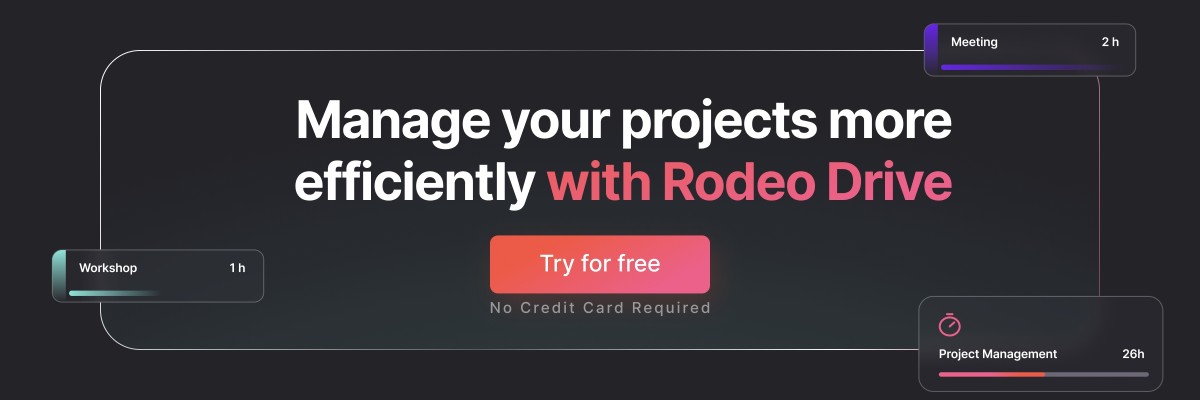How to Calculate Resource Utilization to Achieve More Profitable Projects
85% of project managers oversee multiple projects at the same time. For the average project manager, four to six projects under their belt at a given time isn’t anything unusual. The challenge PMs face is that even when projects increase in scale or duration, the resources available to complete them stay the same.
This makes it pressing to manage the utilization of these resources in a way that gets the most out of them. Because the effectiveness of how project teams spend their time, skills, and energy can lead to dramatically different business outcomes.
Great utilization begins with foresight. This article will explain resource utilization, how to calculate it, and show how project management software, like Rodeo Drive, can provide the visibility needed to better manage utilization.
So, what is resource utilization?
Resource utilization is a key performance indicator in resource planning that tracks how much time employees spend on projects and tasks. A utilization rate is a metric used to monitor that time across those projects and tasks.
Project leaders use utilization rates to measure how effectively an organization is using its time and manpower. That data can be used to allocate resources in a manner that optimizes their use while keeping workloads balanced.
Measuring utilization is especially important for agencies running multiple projects. It ensures that resources are employed efficiently, but not over allocated to where they are unavailable when surprises happen.
Overutilization can lead to burnout and reduced productivity, which is why it's important to prevent it in advance. On the other hand, underutilization leads to wasted capacity, lower employee engagement, and higher project costs. Hence, it’s important to find a sweet spot where each team member is involved but not overburdened.
Resource utilization vs. resource allocation
While often used interchangeably, resource utilization and resource allocation are two distinct, but complementary functions of resource management.
Resource allocation refers to assigning resources to tasks. Allocation takes place at the beginning of the resource planning process. It involves choosing who works on what parts of a project, for how long, and with how much supporting budget and equipment.
Resource utilization instead focuses on the number of hours that resources are scheduled for use. This means it tells you how much time is available throughout your organization and where committed time is going.
Utilization can be thought of as a way to measure the effectiveness of a resource allocation strategy. It looks at whether resources are underused or overburdened, allowing managers to soundly distribute work.
Benefits of monitoring utilization rate
Keeping an eye on your team’s utilization rate can unlock some key benefits for your projects. Here are three of the most important.
1. Boosts profitability and protects timelines
A balanced workload prevents project timelines from overrunning and increasing costs. Timely project completions and lower costs lead to higher profit margins.
Overutilized employees are also less able to commit enough time for creative, high-quality work. Giving employees enough time to complete work keeps them engaged, while the higher-quality projects they deliver as a result help keep clients satisfied and on retainer.
2. Stay ahead of scope creep
Scope creep is when a project expands beyond its initial parameters, increasing costs and consuming ever more precious time.
With a real-time overview of resource usage, project managers can identify when a project is getting too large for the available capacity of an organization. Once it's known that a project is straying off course, a timely intervention can get it back on track — whether it’s reallocating resources, extending the timeline, or reducing the scope altogether.
3. Enhance planning and forecasting
Finally, utilization data is valuable for project planning and forecasting. Since utilization rates paint a comprehensive view of your team’s capabilities and workloads, project managers can use them to set realistic timelines and present accurate expectations to stakeholders.
Resource management software can leverage utilization data to predict trends and potential forecasts in capacity.
Calculating resource utilization rates
Resource utilization is calculated by dividing the hours a person has scheduled on projects by the total amount of time they have available.
There are some twists on the typical resource utilization formula that can be used to measure different types of utilization. But for the purpose of a project-based team, the following two formulas are the most broadly applicable.
Utilization rate formula
The resource utilization formula measures utilization based on billable hours. While non-billable tasks are necessary for any project, maximizing time spent on billable hours optimizes revenue generation.

Let’s look at what this resource utilization formula means.
1. Total billable hours: The number of hours an employee spends on tasks for which clients are billed. These are productive hours that contribute directly to revenue.
2. Total available hours: The total number of hours an employee is available to work over a project period. It usually includes their full-time working hours, while excluding vacations, sick leaves, and non-billable activities.
In practice, if an employee works 40 hours a week but spends 30 hours on billable tasks, their utilization rate would be calculated as (30 billable hours / 40 available hours) x 100, equalling a 75% utilization rate.
Capacity utilization rate formula
A capacity utilization rate is a team-based approach to measuring utilization. It considers utilization across a team to give project managers a view of how effectively the team as a whole is using its time.
The capacity utilization formula considers the individual utilization rates of all team members to get an overall average of the whole team’s utilization. The formula is as follows:
.png)
The capacity utilization formula sums each of these utilization rates and divides them by the total number of employees.
Think of a team with five employees, for instance. If they have individual utilization rates of 80%, 70%, 90%, 60%, and 75%, then the capacity utilization for the team would then be calculated as (375% / 5) x 100, equating to a 75% overall team capacity utilization rate.
A capacity utilization rate is useful for understanding whether your team will have enough availability to adjust if anything unaccounted for happens throughout a project.
Using software to manage resource utilization
For fast-moving agencies or project-based organizations, resource management software can be a game changer.
Project leaders need to juggle tasks, deadlines, team workloads, and of course, keeping projects on budget. Resource management software is like having an extra pair of hands.
Are you making the most of your team’s talents? Is there a risk of missing a deadline? Is time being managed effectively? Rodeo Drive helps project leaders answer all of these questions with agility.

Tracking the number of available hours used in Rodeo Drive
Reports are a great way to understand your team’s utilization at a glance. The Productivity report in Rodeo Drive displays how many hours are scheduled across all of your team’s projects.
The percentage tracked bar on the right column provides a visual representation of how many productive hours team members have spent on a project compared to their available hours, informing you of utilization at a glance.

Track where time is spent in Rodeo Drive
Rodeo Drive’s time tracker provides insight into how team members are using time. These insights give a feel for which tasks are more or less time-consuming than initially planned — allowing for better resource allocation in future projects.
Data from the time tracker is also automatically mirrored in the project budget tab, providing an immediate and accurate financial overview at every step of the project lifecycle.
.png)
Time-tracking insights in Rodeo Drive
Data from the time tracker is moved into your auto-generated Time report. The Time report in Rodeo Drive provides cost data about activities and tells you how your team members spend their time between projects, clients, and activities.
Project leaders can use this information to accurately account for the true financial costs of time and price invoices to reflect those true costs, helping projects stay revenue positive.

Rodeo Drive’s budget updates to reflect the cost of time
Every project has a unique path with different stages. Rodeo Drive’s phased budgeting enables projects to be divided into clear segments with individual activities and expenses.
By breaking down projects into stages, you can allocate resources precisely and avoid overutilization.
For example, a project like developing a new software tool is usually complex and requires several different ‘sub-projects,’ each with multiple deliverables needed to complete that part of the project.
Dividing the project into phases like requirement analysis, design, coding, testing, and deployment, clarifies which resources are needed when.
Project leaders can, for instance, reallocate their UX designers to another project during a coding phase, or avoid allocating developers during a design phase. This maximizes the effectiveness of those resources and avoids sunk time.
5 tips for better resource utilization
We’ve established that better resource utilization increases team efficiency. So you’re probably wondering how you can improve your utilization.
Here are five ways to enhance resource utilization and the overall resource management of your projects.
1. Implement time tracking and blocking
Time tracking provides a picture of how time is spent across different tasks and projects. It’s instrumental in organizing billable hours from non-billable hours, measuring productivity, and calculating budget actuals.
Time blocking is another strategy to boost productivity. By carving out specific blocks of time for tasks, team members can focus and reduce time lost from context-switching.
Assigning tasks to specific blocks of time also has the effect of making them non-negotiable events, preventing them from being overlooked because of other commitments. This leads to better task prioritization and ensures that essential activities are given the attention they need.
2. Move underutilized resources onto billable projects
For project-based teams, resources are often overutilized on non-billable tasks and underutilized on billable tasks.
Non-billable tasks are an unavoidable and necessary part of project work, however, utilization tracking can help you identify when those tasks consume more resources than needed. From there, you can re-allocate your team to higher-priority work.
Utilization metrics can also be used to identify unused time and allocate it to billable tasks, in turn increasing productivity and revenue.
3. Leave some slack when planning utilization
It might feel intuitive to try to maximize utilization, but allowing for some ‘slack’ and buffer time when allocating resources usually leads to better outcomes.
Projects are fluid. Regardless of how well you plan for contingencies, some events can’t be planned for. If all capacity is tied up, it’s impossible to respond to sudden changes or setbacks.
Plus, when teams operate on 100% utilization, there’s a risk they may need to exceed it with overtime, creating the possibility of burnout, missed deadlines, and lower-quality deliverables.
This is why it is generally recommended to keep utilization around 80%. With 80% utilization, project managers can accommodate unforeseen delays and issues, keeping timelines realistic and achievable.
4. Perform regular audits of resources
Conducting regular audits ensures your resources are used with the most efficiency possible. Audits help identify areas of over or underuse, enabling your organization to adjust and for team members to remain accountable.
Reporting features in project management software offer the visibility needed to make audits easy. Rodeo Drive’s reporting keeps time, budgets, and productivity all within view, simplifying the process of conducting regular audits.
5. Use a project management tool with planner capabilities
Most project management tools come with planners that visually represent resource allocation across all ongoing projects.
Visual planners provide project managers with a clear, immediate understanding of who is working on what and when. Having a visual representation also has benefits for the team. Team members can see the overall project timeline and their specific roles within it, fostering better communication between them and the project lead on whether their allocation is realistic.
If a project encounters a change, a visual planner also allows for a quick and efficient reallocation of resources. With Rodeo Drive’s timeline-view planner, managers can drag and drop tasks to new dates, or assign them to team members with availability, giving them the flexibility to adapt to changes on the fly.

Adjust to changes by changing project timelines and reassigning resources
A platform like Rodeo Drive automates the process of measuring utilization. If you’re looking for a project management solution that can help you get the most out of your team and your time, Rodeo Drive just might be your answer.
Start your free trial today to see it in action.








